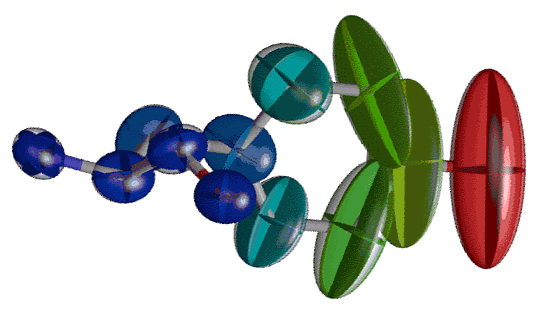 |
Temperature Effects |
 Course Material Index
Course Material Index
 Section Index
Section Index
 Previous Page
Previous Page
Temperature Effects
Temperature will have an effect on the intensities of the powder diffraction
pattern. However it is not an effect that can be expressed as a simple
multiplier, as was the case for example with multiplicity, polarisation,
Lorentz and absorption factors. This is because temperature expresses itself
differently from one atom to another in the structure. The structure factor
equation given earlier yields the diffracted intensities as though all atoms
were stationary. As the temperature rises the atoms execute increased
excursions from their average position. Such excursions can involve complex
coupled motions of several atoms. However if one restricts consideration to
just the independent motions of each atom there is a relatively simple trick
that can be used which is to (artificially) modify the atomic scattering
factors, f, of each atom to represent the net broadening of their
electron clouds resulting from atomic motion. For example a given atom will
have its "stationary" f changed to fT according to:
fT = f exp(−B
sin2θ / λ2)
where T is the temperature and
B = 8π2<u2>
(units of Å2 ), <u2> being the
root mean square displacement of the atom from its average position. The
B values are often referred to as B factors (Debye-Waller is a
another, similar, term often used) and increase with temperature (typical
values are 0.2 to 0.8 Å2 ). So clearly temperature will
modify the diffraction intensities by changing the various values of f
to fT in the structure factor equation, but these changes are
determined by structural refinement methods (rather than by simple multipliers)
and these will be discussed further elsewhere in the course. Before that, one
final point to be explained is that the above method assumes that the B
factors and fT values are the same in all directions.
These are termed isotropic B factors but more challenging refinements
allow each atom to vibrate differently in different directions. This is termed
anisotropic B factor refinement and its result can be illustrated
graphically using individual ellipsoids to indicate the angular profile of
vibration for each atom; an example of this, for the tyrosine molecule in a
structure, is shown below:

Complete Structure Factor Equation
If we now take into account the effect of temperature, the structure factor
equation becomes:
| F(S) = |
Σ
n |
fn Nn exp{2π i (hx +
ky + lz)}
exp(−B sin2θ / λ)
|
for the case of isotropic thermal motion. There is now an additional
multiplier, N, in this final equation for the structure factor,
which takes into account atomic disorder in crystal structures. Thus
an atomic site that is only half occupied will have this value set to 0.5,
which is equivalent to reducing the scattering factor, f, by 50%.
 Course Material Index
Course Material Index
 Section Index
Section Index
 Previous Page
Previous Page


